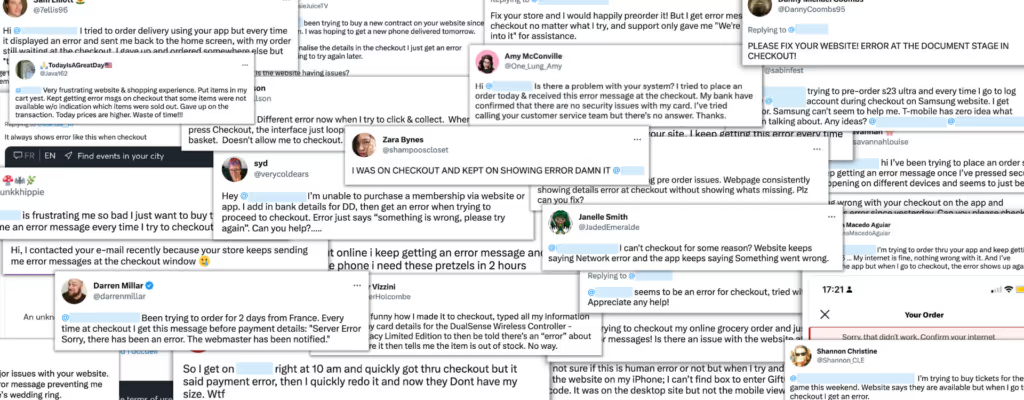Do errors matter if your website isn't your main revenue generator?

While the main reason ecommerce and retail businesses want to eliminate site bugs is to create the clearest, frictionless path to purchase, is this the only reason why a business should focus on website health?
Many retail and ecommerce professionals fall for the fallacy that if their website isn’t their main revenue generator, and is rather used as an information centre for potential customers or partners, they don’t need to invest in site health and maintenance. However, an error’s impact goes far beyond the loss of an online sale: it reaches into brand reputation, trust, loyalty, and longevity.
Website errors are more common than you think
Whether you're a small business or a large corporation, website errors are more common than you think. In fact, in a study conducted into the top online retailers in the US, UK, and Germany, over 3000 bugs were identified on just 52 websites over the 2019 shopping holiday season.
There are a multitude of ways for these errors to get introduced into an ecommerce system, but that’s not what we’re here to talk about. What we are here to discuss is why retail companies with an online presence need to start paying attention to site errors, regardless of whether or not their website is a main revenue driver.
If your website generates revenue in any capacity, site errors can cost you a lot of money
If your ecommerce site is your company’s main source of revenue, or even if the website only accounts for a small portion of your revenue, anything that is blocking customers from interacting with the environment as planned can be incredibly detrimental to your business, and can cause you to lose online sales.
At best, errors can cause frustration with customers, leaving them with a sour taste in their mouth. At worst, errors can block potential customers from completing their checkout flow.
Either way, when customers aren’t served that perfect experience, performance metrics go down and the potential for online-sourced revenue diminishes.
This is obviously a huge concern for retailers whose main source of revenue is from their ecommerce environment, but…
What about if your site isn’t your main revenue generator?
Even if your site isn't your main revenue generator, it still matters how it looks and performs. Why? Because site errors can impact:
- Your reputation with customers. If customers find that you are not providing them with a good experience, they can easily go elsewhere to make their purchases or do business with another company.
- Your trustworthiness among customers who are looking for information about companies like yours online before making decisions on who they want to buy from. If customers are presented with a broken website, their expectations have already not been met, which could lead them into believing that this will be the same case if they purchase a product from that provider.
Both of these can impact the overall growth of your business in a big way. They diminish the likelihood a prospective customer will return to (or even begin to patronise) your store, and greatly decrease the chances that they will refer their peers. What’s worse is that often, customers will also take to social media to express their dissatisfaction with a poor experience, which further amplifies a negative opinion of your brand.

Customers may also leave negative reviews because of their experience - and those reviews can hurt future growth by scaring away potential buyers who read them before making a decision about whether or not they should buy from you. With such a huge emphasis on customer ratings and satisfaction in the industry today, negative reviews are a glaring red flag for consumers.
Site errors can impact visitors’ trust in your brand and their loyalty to it
Think about how you feel when you see a spelling mistake in an article or report. It takes away a bit of your confidence in that piece, doesn’t it? The same can be said for a site with errors.
Impressions matter, and unaddressed site bugs lead to prospective customers having a sense of distrust and unreliability around your business. This can be a dangerous combination for any business!
If a visitor encounters an error, they may assume that there are other issues with the website, and the company, that they haven’t noticed yet. They may fear that the company doesn’t pay attention to detail or care about customers’ experiences. This breeds a lot of negative emotions and makes it incredibly difficult to foster ongoing loyalty from both existing and prospective customers.
Don’t let bugs get in the way of growing your business
The most important thing to remember is that your site’s main purpose is to provide a great customer experience, regardless of whether or not it’s the main point of sale for your business. If your ecommerce site doesn’t look professional, reliable, or trustworthy, you risk seriously damaging your brand.
The bottom line of all this is that website errors are not just a nuisance. They can have a real impact on your business, whether or not your website is being used to drive the majority of your sales. Your website can be your most important marketing tool if it’s well maintained, but if it's riddled with errors, customers won't find it easy to use or trust your brand.
So even if you don't think errors matter because they're not directly blocking revenue - they do!




